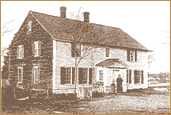Site currently under construction. Thank you for your patience!
A National Historic Site
in Hampton, NH
The James House Museum
Managed and owned by the James House Association

_____________________ 1892
The James House is recognized as a true "first period" colonial. The house built for Benjamin James in 1723, near the salt meadows of Hampton, New Hampshire, is regarded as perhaps the earliest surviving example of the two-room deep, center-chimney colonial in New
Hampshire. All of its original framing remains intact.
Welcome to the James House Museum!
Thank you for visiting! This historic jewell is representative of three architectural styles belonging to years past and bygone days that would be lost to future generations if not for its caretakers and interested citizens like you! The President and members of the Board of Directors offer educational programs and tours throughout the house and property, in addition to public events such as weaving demonstrations, concerts, ghost hunts, séances and special Halloween events in the fall. Each year we explore new ways to enjoy and support the James House. Any and all contributions are greatly appreciated as we continue to preserve this gift of yesteryear.
Thanks again for visiting!

_____________________
1997
Added to the National Register of Historic Places in 2002, the James House presents an important opportunity to preserve the architectural and historic value of a rare first period house. Our preservation projects and programs of discovery bring visitors into the home and workshop of the early 18th century craftsman.


____________________
2018
____________________________________ 2021
With clapboard siding nearly complete, our Master Carpenter is nearing his goal of recreating an historic exterior facelift. The new siding will armor the building against the natural degrading effects of the elements.
Period-appropriate color and paint-type have added another layer of protection to the James House. One of the last steps in this preservation process is providing a new shake roof. We've nearly reached our goal of saving this jewell for future generations!
HISTORY
*Learn about the 300th anniversary of Benjamin James' and Suzanna Smith's wedding.
A Brief History of the James House
Benjamin James arrived in Hampton from Newbury, Massachusetts in about 1690, to learn the trade of weaver. Apprenticed to John Stockbridge, young Benjamin was only 17. When his apprenticeship was completed, Benjamin James married Susanna Smith, daughter of John Smith, the tailor, on July 23, 1702*.
On November 20, 1705, Benjamin James purchased from Zechariah Brackett, also a weaver, four acres of upland on the Drakeside. Tradition (sometimes unreliable) has it that he built a small house there in 1707. There is some evidence to support the claim, according to Robert Pothier, a master craftsman specializing in First Period restoration, that the ell attached to the main house is that first structure.
Not long after, Benjamin James built the present house, facing south toward the salt marshes and running from the Drakeside to the sawmill on Taylor River. Benjamin was a hardworking, ambitious farmer and weaver. There can be no doubt that he became prosperous by 1723 in order to build such a large house with so many fine features.
Benjamin's son, Jabez, also trained to become a weaver, set up a loom by his father's. Together, they established a flourishing business. Jabez' son Joshua also trained to follow in his father's and grandfather's footsteps, to become a weaver. During the Revolutionary War, Joshua served on a committee in 1775 to gather twenty-three blankets to meet the town's quota, which were delivered to the Continental Army then quartered at Cambridge. Some may have come from the James' looms.
Later, Joshua, of the third generation, made the first alterations to the house. Between 1790 and 1800 - or thereabout - a vestibule in the Federal style was added to the front entry. Likely done by Joshua's son Edmund, who had recently completed apprenticeship as a house joiner, its Federal style windows still remain.
Captain Edmund inherited the house along with the loom and warping bars, but he did not follow the family trade of weaving. As a house-joiner Edmund introduced finely finished work in the Federal style throughout the house, some of which remains. His inventoy lists a joiner's bench and "many saws". A shareholder in Coffin's mill, he took his turn there as a sawyer.
Are you a descendant of Benjamin James? Email us and exchange genealogies!
Edmund's son Joshua II apprenticed as a carpenter, and he inherited his father's share at Coffin's saw mill. At his premature death in 1858 the property was left to his wife Martha Ann, who made the most sweeping alterations to the house. During this period the massive central chimney was removed, thereby opening up the formerly cramped entry (known then as the porch) into a spacious hall. A straight-run, easy climb stairway, in mid-Victorian style, ascended to the second story. Two narrow, widely spaced chimneys were built to accommodate wood-burning stoves, a new and better way of heating.
Joshua II's widow Martha Ann carried on farming by raising hogs. There is evidence that their son Joshua Edmund and his wife Jennie earned their living with a small dairy farm around the turn of the twentieth century. They were responsible for the installing the Victorian style windows, replacing the Federal windows. Joshua E.'s health began to fail, and by 1922 he had suffered his fourth paralytic stroke. Finances, of course, had become severely strained.
Their son, J. Hale did not choose to earn his living by farming. Although not able to run the farm during his father's illness, he helped his parents maintain it in other ways. However, in 1930, at age 42, J. Hale died suddenly from a massive stroke. Left with no heirs, Jennie had no choice but to sell the James farm, its pastures, woodland, and marshes, to the Winfred L. Campbell family. AreAfter two hundred and twenty-six years, the ancestral acres left the James family forever.
A brief history of seacoast New Hampshire, home of the James House



